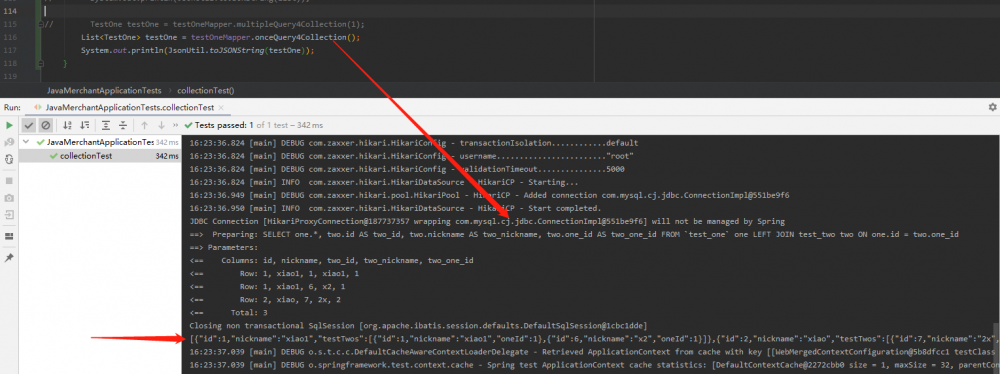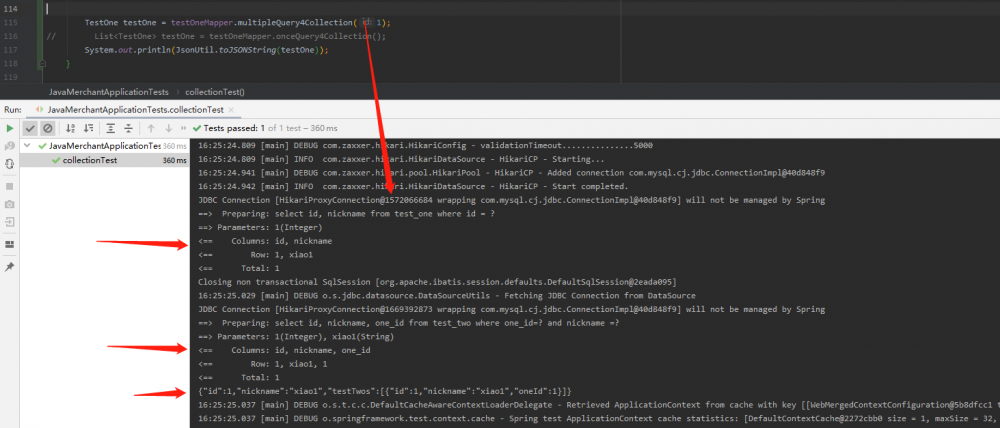mybatis中collection association优化使用及多参数传递
mybatis都会用,但要优雅的用就不是那么容易了
今天就简单举例,抛砖引玉,供大家探讨
1.主表
CREATE TABLE `test_one` ( `id` int(11) NOT NULL AUTO_INCREMENT, `nickname` varchar(255) NOT NULL, PRIMARY KEY (`id`) ) ENGINE=InnoDB AUTO_INCREMENT=3 DEFAULT CHARSET=utf8;
对应的java实体类如下(自动生成的代码,省略get set)
@JsonIgnoreProperties(ignoreUnknown = true, value = {"handler"})
public class TestOne implements Serializable {
private static final long serialVersionUID = 1L;
private Integer id;
private String nickname;
@JsonIgnoreProperties(ignoreUnknown = true, value = {"testOne"})
private List<TestTwo> testTwos = new LinkedList<>();
注意:JsonIgnoreProperties请忽略,这是解决对象间循环依赖在json序列化时出错的,不在本次内容中
2.从表
CREATE TABLE `test_two` ( `id` int(11) NOT NULL AUTO_INCREMENT, `nickname` varchar(255) NOT NULL, `one_id` int(11) NOT NULL, PRIMARY KEY (`id`), KEY `test_two_ibfk_1` (`one_id`), CONSTRAINT `test_two_ibfk_1` FOREIGN KEY (`one_id`) REFERENCES `test_one` (`id`) ) ENGINE=InnoDB AUTO_INCREMENT=8 DEFAULT CHARSET=utf8;
对应的java实体类如下(自动生成的代码,省略get set)
@JsonIgnoreProperties(ignoreUnknown = true, value = {"handler"})
public class TestTwo implements Serializable {
private Integer id;
private String nickname;
private Integer oneId;
@JsonIgnoreProperties(ignoreUnknown = true, value = {"testTwos"})
private TestOne testOne;
注意:JsonIgnoreProperties请忽略,这是解决对象间循环依赖在json序列化时出错的,不在本次内容中
细心的同学发现,两个表用同名字段,后续会告诉为什么这么举例,而且这种情况项目中是非常常见的
3.TestOneMapper.xml
1 <?xml version="1.0" encoding="UTF-8"?>
2 <!DOCTYPE mapper PUBLIC "-//mybatis.org//DTD Mapper 3.0//EN" "http://mybatis.org/dtd/mybatis-3-mapper.dtd">
3 <mapper namespace="info.zycloud.xcx.merchant.dao.TestOneMapper">
4 <resultMap id="BaseResultMap" type="info.zycloud.xcx.merchant.model.TestOne">
5 <constructor>
6 <idArg column="id" javaType="java.lang.Integer" jdbcType="INTEGER"/>
7 <arg column="nickname" javaType="java.lang.String" jdbcType="VARCHAR"/>
8 </constructor>
9 </resultMap>
10
11 <!--一次查询查出collection-->
这里会一次查询就查询出主对象和关联的list对象, 查询语句是一个join语句
12 <resultMap id="OnceQueryBaseResultMap" type="info.zycloud.xcx.merchant.model.TestOne" extends="BaseResultMap">
13 <collection property="testTwos" resultMap="info.zycloud.xcx.merchant.dao.TestTwoMapper.BaseResultMap"
14 columnPrefix="two_"/> 由于两个表有同名字段,所以需要做区分,这里可以采用前缀,就可以共用之前的ResultMap了
15 </resultMap>
16
17 <select id="onceQuery4Collection" resultMap="OnceQueryBaseResultMap">
18 SELECT
19 one.*, 为什么要用*,是为了防止主表字段变了,因为这里是引用的生成的baseresultMap
20 two.id AS two_id,
21 two.nickname AS two_nickname,
22 two.one_id AS two_one_id
23 FROM
24 `test_one` one
25 LEFT JOIN test_two two ON one.id = two.one_id
26 </select>
27
28 <!-- 多次查询查出collection-->
29 <resultMap id="MultipleQueryBaseResultMap" type="info.zycloud.xcx.merchant.model.TestOne" extends="BaseResultMap">
30 <collection property="testTwos" column="{oneId=id,nickname=nickname}" 多参数时在column中用"{}"将参数包起来, =左侧的为mapper中定义的param, =右侧为主查询的数据库字段名
31 select="info.zycloud.xcx.merchant.dao.TestTwoMapper.selectByOneId"/>
32 </resultMap>
33
34 <select id="multipleQuery4Collection" parameterType="java.lang.Integer" resultMap="MultipleQueryBaseResultMap">
35 select
36 <include refid="Base_Column_List"/>
37 from test_one
38 where id = #{id,jdbcType=INTEGER}
39 </select>
40
41 </mapper>
对应的接口定义
1 public interface TestOneMapper {
2
3 List<TestOne> onceQuery4Collection();
4
5 TestOne multipleQuery4Collection(Integer id);
6 }
3.TestTwoMapper.xml
<?xml version="1.0" encoding="UTF-8"?>
<!DOCTYPE mapper PUBLIC "-//mybatis.org//DTD Mapper 3.0//EN" "http://mybatis.org/dtd/mybatis-3-mapper.dtd">
<mapper namespace="info.zycloud.xcx.merchant.dao.TestTwoMapper">
<resultMap id="BaseResultMap" type="info.zycloud.xcx.merchant.model.TestTwo">
<constructor>
<idArg column="id" javaType="java.lang.Integer" jdbcType="INTEGER"/>
<arg column="nickname" javaType="java.lang.String" jdbcType="VARCHAR"/>
<arg column="one_id" javaType="java.lang.Integer" jdbcType="INTEGER"/>
</constructor>
</resultMap>
<select id="selectByOneId" resultMap="BaseResultMap">
select
<include refid="Base_Column_List"/>
from test_two
where one_id=#{oneId} and nickname =#{nickname}
</select>
</mapper>
1 public interface TestTwoMapper {
2 List<TestTwo> selectByOneId(@Param("oneId") Integer oneId, @Param("nickname") String nickname);
3 }
解释了然后我们执行看下效果:
onceQuery4Collection:

multipleQuery4Collection:

正文到此结束
热门推荐
相关文章
Loading...











![[HBLOG]公众号](https://www.liuhaihua.cn/img/qrcode_gzh.jpg)

